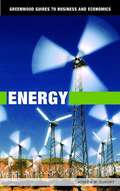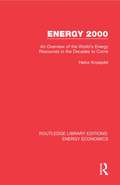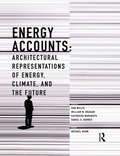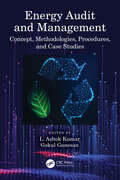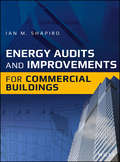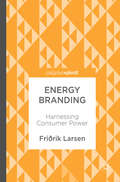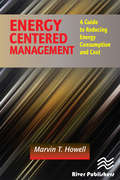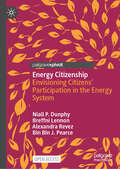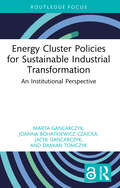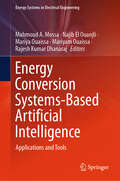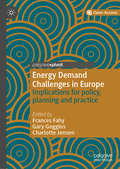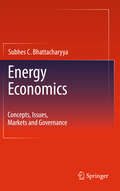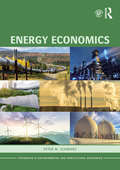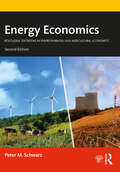- Table View
- List View
Energize: Make the Most of Every Moment
by Simon Alexander OngWinner of the 2023 Business Book Award for Wellness and Wellbeing'This book is exactly what we need in this moment' Simon Sinek, author of Start With Why'Learning how to manage your energy changes your life. Don't just read this book, do it!' Marie Forleo, author of Everything is FigureoutableIn Energize, award-winning life coach Simon Alexander Ong introduces you to the art and science of energy management. In a world where we are always on, Ong coaches you to work with your natural energy resources to recognize your most energized state - when to push and when to recoup - so that you can work sustainably towards your biggest goals.You'll learn how to:- Speak less and listen more- Stop treating your health as a side hustle- Silence your inner critic and listen to your inner guide instead- Progress faster by saying no to the activities that are holding you backIt's time to find out what you can achieve when you feel energized.'Simon provides practical advice to help you achieve your full potential in every area of your life. Exceptional!' Dr Marshall Goldsmith, author of Triggers'Learning how to energize ourselves is key to being happy and successful' Shaa Wasmund MBE, author of How to Fix Your Sh*t
Energizing Management Through Innovation and Entrepreneurship: European Research and Practice (Routledge Studies in Innovation, Organizations and Technology)
by Milé TerziovskiThis book provides an in-depth understanding of key variables that play a significant role at the various stages of the innovation process, leading to successful commercialisation of products and services. Combining interdisciplinary studies in entrepreneurship and innovation, the book consists of contributions focusing on theory, research and practise in the field of innovation, management and entrepreneurship. The role of the entrepreneur is addressed as an innovator who recognises opportunities and convert these into marketable products and services through personal commitment, financial resources and management skill; taking appropriate level of risk. Terziovski has selected a variety of chapters focusing on a wide ranging number of topics including corporate entrepreneurship, entrepreneurial learning strategies, the impact of entrepreneurial practises on competitiveness, human resource management and knowledge management. The main conclusion of the analysis in these chapters is that there is a strong relationship between innovation and entrepreneurship. Moreover, this book articulates two contradictory schools of thought; first that firms with a higher entrepreneurial orientation have higher relative international sales and operate in a greater number of foreign countries; and secondly that entrepreneurial orientation is not associated with subsidiary financial or market performance, but is positively and significantly associated with subsidiary idea generation which are subsequently converted into marketable products and services through the innovation process. This book acts as a negotiation between these two perspectives.
Energizing the Groundswell: Using Social Technology to Turn Your Most Enthusiastic Customers into Evangelists
by Charlene Li Josh BernoffWhen political candidates get their supporters riled up and spreading the word, we call it "energizing the base." It's the same with companies and their customers. Energizing the base is a powerful way to take advantage of the groundswell and amplify the "buzz" around your products and services. In this chapter, social media strategy leaders Charlene Li and Josh Bernoff illustrate this key strategy- charging up your best customers and enabling them-using social media technologies-to recruit their peers through positive word of mouth. The techniques highlighted in this chapter are ratings, reviews, and online communities, with case studies featuring online retailer eBags, email services company Constant Contact, and toy company Lego. This chapter was originally published as Chapter 7 of "Groundswell, Expanded and Revised Edition: Winning in a World Transformed by Social Technologies."
Energy
by Joseph M. DukertEnergy: We want it affordable, we want it available in ample quantities and from reliable sources, and we want it to be produced and used in ways that are safe and environmentally benign.
Energy 2000: An Overview of the World's Energy Resources in the Decades to Come (Routledge Library Editions: Energy Economics)
by Heinz KnoepfelOriginally published in 1986, this book takes an inter-disciplinary approach to the options for energy in the future. Written in a clear, easy-to-read style, it proposes that future solutions should not be based solely on cost, given our plentiful energy resources, but on ecological, human and ethical considerations. The book features a quantittive review of energy sources, supported by numerous figures and tables, that includes such long-term solutions as nuclear fission and solar energy. The book allows engineers and students to easily weigh the pros and cons of all energy options to realistically plan for the future.
Energy Accounts: Architectural Representations of Energy, Climate, and the Future
by Michael MannHow does one tell the story of energy production, use, or conservation in a manner sufficiently convincing to influence policy, behavior, and design? Energy Accounts explores potential answers to this question through compelling images, data visualizations, narratives, and other examples of accounting for energy. Organized into a collection containing both examples of best practices and critiques, this impressive array of projects and contributors combines text and graphic material to explore different representations of energy data. Including work from Kieran Timberlake, SHoP, AMO, Lateral Office, WOHA, and many more, the book boasts a unique graphic design which supports and enhances its role as a valuable resource for professionals and students in architecture, engineering, and urban design.
Energy Analysis for a Sustainable Future: Multi-Scale Integrated Analysis of Societal and Ecosystem Metabolism
by Mario Giampietro Kozo Mayumi Alevgül H. ŞormanThe vast majority of the countries of the world are now facing an imminent energy crisis, particularly the USA, China, India, Japan and EU countries, but also developing countries having to boost their economic growth precisely when more powerful economies will prevent them from using the limited supply of fossil energy. Despite this crisis, current protocols of energy accounting have been developed for dealing with fossil energy exclusively and are therefore not useful for the analysis of alternative energy sources. The first part of the book illustrates the weakness of existing analyses of energy problems: the science of energy was born and developed neglecting the issue of scale. The authors argue that it is necessary to adopt more complex protocols of accounting and analysis in order to generate robust energy scenarios and effective assessments of the quality of alternative energy sources. The second part of the book introduces the concept of energetic metabolism of modern societies and uses empirical results. The authors present an innovative approach – Multi-Scale Integrated Analysis of Societal and Ecosystem Metabolism (MuSIASEM) – capable of characterizing the quality of alternative energy sources in relation to both environmental constraints and socio-economic requirements. This method allows the metabolic pattern of a society to be described in relation to its feasibility, when looking at biophysical factors, and desirability, when looking at socio-economic factors.Addressing the issue of scale in energy analysis by cutting through the confusion found in current applications of energy analysis, this book should be of interest to researchers, students and policy makers in energy within a variety of disciplines.
Energy Audit and Management: Concept, Methodologies, Procedures, and Case Studies
by L. Ashok Kumar Gokul GanesanThis book describes the energy management concepts, energy audit principles, resource efficiency, and other energy conservation opportunities involved in different sectors across varied industries. Real-time case studies from various large industrial sectors, like cement, paper and pulp, refineries, manufacturing, garments and textile processing, power plants, and other MSME industrial sectors with cross functional energy conservation opportunities, are included. It also describes the future scope of energy auditing and management including IoT and data analytics. It also helps to gather the energy generated and utilization, energy conservation, and other process related data. Features: Provides entire coverage of energy management and audit concepts. Explores energy audit methodologies and energy saving initiatives. Incorporates current technologies like machine learning, IoT, data analytics in energy audit for reliability improvement. Includes case studies covering detailed energy saving calculation with investment pay back calculations. This book is aimed at researchers, professionals, and graduate students in electrical engineering, power systems, energy systems, and renewable energy.
Energy Audits and Improvements for Commercial Buildings
by Ian M. ShapiroThe Intuitive Guide to Energy Efficiency and Building Improvements Energy Audits and Improvements for Commercial Buildings provides a comprehensive guide to delivering deep and measurable energy savings and carbon emission reductions in buildings. Author Ian M. Shapiro has prepared, supervised, and reviewed over 1,000 energy audits in all types of commercial facilities, and led energy improvement projects for many more. In this book, he merges real-world experience with the latest standards and practices to help energy managers and energy auditors transform energy use in the buildings they serve, and indeed to transform their buildings. Set and reach energy reduction goals, carbon reduction goals, and sustainability goals Dramatically improve efficiency of heating, cooling, lighting, ventilation, water and other building systems Include the building envelope as a major factor in energy use and improvements Use the latest tools for more thorough analysis and reporting, while avoiding common mistakes Get up to date on current improvements and best practices, including management of energy improvements, from single buildings to large building portfolios, as well as government and utility programs Photographs and drawings throughout illustrate essential procedures and improvement opportunities. For any professional interested in efficient commercial buildings large and small, Energy Audits and Improvements for Commercial Buildings provides an accessible, complete, improvement-focused reference.
Energy Audits: Theoretical Examination and Modeling of Energy Audits (Sustainable Management, Wertschöpfung und Effizienz)
by Michael Krutwig Adrian Dumitru TanțăuExisting literature on energy audits consists almost exclusively of practical guides. This book looks at energy auditing from a scientific perspective. It discusses the nature of energy audits and provides a universally applicable data model as a basis for automatic processing of a large number of energy audits. Qualitative aspects of auditing are discussed in detail. The modeling enables an improved evaluation of subsidy programs for energy audits, but also a systematic and teamwork-oriented creation of energy audits.
Energy Branding
by Friðrik LarsenDemonstrating the potential of building strong brands in the energy sector, this book explores the challenges of shifting the perception of energy from a commodity business into a consumer brand. Energy suppliers are increasingly being met with skepticism, indicating the need for a greater focus on marketing and branding in the energy industry. The author examines both perspectives of energy as a commodity business and a consumer brand, as well as the perception of energy consumers across Europe. Topics discussed include green energy, the liberalisation of the electricity industry, and the relationship between consumers and executives in the energy market. One of the first of its kind, this book offers a unique and innovative study of the development of branding in the energy industry, and sheds light on future marketing strategies.
Energy Capitol: The Waning of Regulatory Form (Routledge Studies in Energy Policy)
by Arthur MasonEnergy Capitol explores the waning of regulatory politics surrounding large-scale energy systems in the United States at the turn of the millennium.Throughout the twentieth century, large-scale energy systems in North America and Europe were highly regulated by a national political community whose decision-making authority relied on positions of bureaucratic and capitalist-led industry organization. After restructuring in energy markets such as natural gas and electricity during the 1980s, the culture of power surrounding political decision-making began to decline. Against this backdrop, Arthur Mason examines the struggle by oil companies and federal-state agencies to deliver natural gas from Alaska and Canada’s Mackenzie Valley to markets in midcontinental United States, highlighting regulatory collusion to advance their plans. Mason employs perspectives from anthropology, political science, sociology, and science and technology studies to analyze ethnographic data gathered at the Alaska State Legislature and in the Office of the Alaska Governor in Washington, D.C. The focus is primarily on plans for building an estimated $20 billion 3,500 mile pipeline to transport natural gas from the North American Arctic to midcontinental pipeline infrastructure in the United States. By illuminating key aspects of federal-state political decision-making processes on energy transportation infrastructure, Mason highlights the activities of economists, lawyers, and other regulatory intellectuals whose accumulated work impedes Arctic proposals through a reliance on judgments that no longer reflect the conditions in which large-scale projects are increasingly determined.Written by a leading expert in the field, this book will be of great interest to students and scholars of energy policy, environmental politics, governance, and regulation and risk. It will also be relevant to industry professionals working in environmental NGOs and government departments in energy and climate forecasting.
Energy Centered Management: A Guide to Reducing Energy Consumption and Cost
by Marvin T. HowellThis book provides organizations with a guide to planning, developing, and implementing an energy reduction and management program. It is specially designed to achieve energy reduction deployment including top management for all employees and onsite contractors. Energy reduction deployment (ERD) can be implemented by itself and render significant savings; however, for even greater savings, this book shows how to implement energy centered management systems (ECMS) which can be in congruence with ISO 50001. This book assists in the hunt for energy waste and is designed to thoroughly cover ECMS plus addresses what additions are necessary to have ECMS conform to ISO 50001 Energy Management System (EnMS). It provides a checklist and information on how to perform an internal audit or self-inspection and discusses how to create an energy awareness organization culture.
Energy Citizenship Across Europe: Contexts and Conditions for an Emerging Energy Transition
by Frances Fahy Edina VadovicsThis open access book is intended to provoke and progress new thinking in the field of energy research for policy makers, practitioners and scholars. By drawing on a broad range of social and innovation theory insights, this book showcases the diversity of energy citizenship and opens up the concept by including multiple ‘latent’, less visible, forms of energy citizenship that also form part of the energy transition. Focusing on how energy citizenship is considered in eight countries across Europe, each of the contributions highlight the empirical variety, the geographical differences, the contextual challenges, and the socio-political histories out of which energy citizenship develops. In exploring if there are certain convergences and similarities across contexts, the collection makes a significant contribution to debates and discussions surrounding the European Energy Union.
Energy Citizenship: Envisioning Citizens’ Participation in the Energy System
by Niall P. Dunphy Breffní Lennon Alexandra Revez Bin Bin PearceThis open access book develops a deeper understanding of an increasingly applied term across policy cycles and academic discourses, ‘energy citizenship’. It provides the reader with five distinct chapters, with each in turn examining a specific aspect of the concept and how it has manifested in public discourses.
Energy Cluster Policies for Sustainable Industrial Transformation: An Institutional Perspective (Routledge Open Business and Economics)
by Marta Gancarczyk Joanna Bohatkiewicz-Czaicka Jacek Gancarczyk Damian TomczykEnvironmental changes and related public policies require an energy-focused sustainable industrial transformation (SIT) that reconciles economic, environmental, and social objectives. Local energy clusters are conducive to these transformative processes since they represent institutional structures that link key actors and factors in territorial communities to form niches for the green transition. However, SIT policies at the local level are in a nascent stage, and empirical evidence on these processes remains scarce. Furthermore, it is necessary to advance a conceptual background for SIT and identify the development conditions for territorial energy communities. In response to these theory- and policy-related challenges, this monograph aims to conceptualize the role of energy cluster policies in SIT using an institutional approach, as well as to identify the progress of the energy cluster policies and the development stages, drivers, and obstacles of local energy clusters. The author’s empirical basis will be Polish energy clusters analyzed against international policies and experience in territorial energy communities.This book provides unique value by developing an institutional analytical framework for energy cluster policies, identifying the conditions for the development of energy clusters, and proposing actionable policy recommendations in this area.The Open Access version of this book, available at http://www.taylorfrancis.com, has been made available under a Creative Commons Attribution-Non Commercial-No Derivatives (CC BY-NC-ND) 4.0 license.
Energy Conservation and Management for Professionals (River Publishers Series in Energy Management)
by Benard MakaaThis book is a comprehensive look at the strategies, technologies, and policies driving the transition to sustainable energy management. The content is designed to convey the technical aspects of energy systems and the socioeconomic and environmental imperatives that require a shift toward more sustainable practices. It covers a wide range of topics relevant to current and future energy challenges, including the complexities of designing energy-efficient buildings and national energy policies.The book is a self-study guide for energy and non-energy professionals who either lack formal training in the subjects of energy management and conservation or simply need a means to refresh their knowledge in these subjects. Energy professionals, policymakers and government officials, academics and students, and environmentally conscious individuals will find it a useful resource. We hope this book gives you the knowledge and confidence you need to act, inspires you to come up with new solutions, and encourages you to lead by example. Let us look at how we can make a significant difference through conscious energy management and conservation.
Energy Conversion Systems-Based Artificial Intelligence: Applications and Tools (Energy Systems in Electrical Engineering)
by Mariya Ouaissa Mariyam Ouaissa Rajesh Kumar Dhanaraj Mahmoud A. Mossa Najib El OuanjliThis book aims to propose advanced solutions based on artificial intelligence techniques for ECS in order to increase energy efficiency, ensure the safety of the ECS, and to improve the quality of the energy supplied to the grid. The efficiency and quality of the electrical energy produced depends mainly on the structure and efficiency of the control technology developed for the Energy Conversion System (ECS). To improve the performance of ECSs, it is interesting to design control systems that emulate some functions performed by the human brain. Among these interesting functions are self-adaptation, learning, flexibility of operation and planning in the presence of large uncertainties and with minimal information. Based on these aspects, artificial intelligence (AI) techniques can be developed and applied to solve the different control problems of ECSs. For academics, professionals, practitioners, and graduate students interested in the most recent research on the application of AI in ECS, it is the ideal reference source.
Energy Cooperation in South Asia: Utilizing Natural Resources for Peace and Sustainable Development (Routledge Explorations in Energy Studies)
by Mirza Sadaqat HudaThis book analyses the key political challenges to regional energy cooperation in South Asia. It argues that investment in the planning of regional energy projects can increase their viability and also drive integration and peacebuilding. Regional cooperation has been substantiated by academics and multilateral development banks as one of the most viable solutions to South Asia’s crippling energy crisis. However, three decades of national and regional efforts have failed to develop a single multilateral energy project or foster high levels of bilateral cooperation. Using data collected through extensive interviews with policymakers in India, Bangladesh, Pakistan and Nepal, this book identifies the specific roadblocks to energy cooperation – including domestic politics and the failure of leadership on multiple levels - and evaluates how these political challenges determine regional interactions on energy securitisation, environmental cooperation and human rights. Huda then undertakes case studies on four transnational energy projects to highlight specific policy recommendations to overcome these challenges, suggesting planning mechanisms through which the significant issue of energy cooperation in South Asia can be addressed. This book will be of great interest to students and scholars of energy security and geopolitics, natural resource governance and South Asian politics.
Energy Costs and Farm Characteristics in the European Union: Highlighting Linkages with Structural and Policy Dimensions (SpringerBriefs in Applied Sciences and Technology)
by Vítor João MartinhoThis book explores the relationships between the energy costs and other farm variables in the European Union (including the UK) over a recent period of six years. It examines labour, farm land area, outputs/inputs, investments, assets, taxes, and subsidies in the context of policy measures and the farm structure. The book provides a deep insight into how energy cost and other factors in the farming sector relate to each other and as a result how farm planning can be made more efficient, more environmentally sustainable and more competitive. It will be of interest to policy-makers, governments, researchers and advanced students of economics, policy and the environment.
Energy Demand Challenges in Europe: Implications for policy, planning and practice
by Frances Fahy Gary Goggins Charlotte JensenThis open access book examines the role of citizens in sustainable energy transitions across Europe. It explores energy problem framing, policy approaches and practical responses to the challenge of securing clean, affordable and sustainable energy for all citizens, focusing on households as the main unit of analysis. The book revolves around ten contributions that each summarise national trends, socio-material characteristics, and policy responses to contemporary energy issues affecting householders in different countries, and provides good practice examples for designing and implementing sustainable energy initiatives. Prominent concerns include reducing carbon emissions, energy poverty, sustainable consumption, governance, practices, innovations and sustainable lifestyles. The opening and closing contributions consider European level energy policy, dominant and alternative problem framings and similarities and differences between European countries in relation to reducing household energy use. Overall, the book is a valuable resource for researchers, policy-makers, practitioners and others interested in sustainable energy perspectives.
Energy Dynamics and Climate Mitigation: An Indian Perspective (Advances in Geographical and Environmental Sciences)
by Asheem SrivastavThis book analyzes the current approaches to energy management in India that is based on a carbon-intensive pathway, which if continued, may have serious implications for climate change mitigation with severe consequences for human health and survival. India, being a signatory to the United Nations Framework Convention on Climate Change (UNFCCC), the Kyoto Protocol, and the Paris Agreement, is committed to reducing greenhouse gas emissions; however, the country’s dilemmas are whether to prioritize environment over economy or vice versa and also whether economic growth can be sustained by relying on carbon-intensive development. Those are explored in this book. The Indian economy is poised for a big leap in the near future, and the topmost priority of the government is to ensure energy security, accessibility, and affordability for nearly 1.5 billion people. Currently, 70% of India’s electricity generation comes from coal- and oil-based thermal power plants, and only 12–15% of energy is generated from renewable sources. Experts are of the view that the demand for coal and gas power generation will continue to rise and is expected to reach the equivalent of nearly 2 billion t of oil by 2030. The annual consumption of natural gas is expected to increase fourfold to 200 billion m3 a year in the near future, and its share in the primary energy basket of coal, oil, and gas will rise from 6.5% to 15% by 2030. This will not only cause a significant drain on foreign reserves but will also pose an enormous challenge to policymakers and scientists. This book serves as a useful guide in shaping India’s future energy policy.
Energy Economics
by Subhes C. BhattacharyyaSince its modest beginning in the 1970s, the academic and research focus on energy has grown substantially and energy has established itself as an independent, interdisciplinary subject area. It attracts attention from people in a range of different fields including engineers, scientists, geologists, environmentalists, bankers, investors, policy makers and politicians. Energy Economics introduces the basic concepts of energy economics and explains how simple economic tools can be used to analyse contemporary energy issues. Energy Economics is organised into six parts that give the reader a thorough grounding in various key aspects of the subject: basic demand-related concepts and ideas used in energy economics; supply-side economics;energy markets, with specific emphasis on oil, gas and coal;the application of simple economic principles in analysing contemporary energy issues;environmental aspects of energy use; andregulatory and governance issues. Energy Economics is an easily accessible reference book for students of energy economics at the postgraduate level, as well as for a wider interdisciplinary audience. It provides readers with the skills required to understand and analyse complex energy issues from an economic perspective.
Energy Economics (Routledge Textbooks in Environmental and Agricultural Economics)
by Peter M. SchwarzWith interest in topics such as climate change, energy security, and alternative energy sources being at an all-time high, the effects of today's decisions now rest on the shoulders of future generations. There are no easy answers to our energy issues, so costs and benefits must be considered when evaluating all energy alternatives; alongside that, prices must be right and need to reflect the full social costs to society of a given source of energy. Energy Economics outlines the fundamental issues and possible solutions to the challenges of energy production and use, and presents a framework for energy decisions based upon sound economic analysis. It considers market forces and policy goals, including economic prosperity, environmental protection, and other considerations that affect societal well-being. This book focuses on both energy choices and the impact of these choices on market performance, environmental conditions, and sustainability. The initial section covers the fundamental economic concepts for analyzing energy markets. Following this, a detailed analysis of established energy sources, specifically fossil fuels and nuclear energy, leads into consideration of energy alternatives such as renewable energy and next-generation alternatives. Electricity production and regulatory trends are covered in depth. The final section considers policy: environmental considerations, sustainability, and energy security. The concluding chapter is a comprehensive vision for our energy future. Drawing on current energy headlines, perspectives familiar from the popular press, and views outside economics, this text sharpens students' ability to understand, evaluate, and critique policy using appropriate economic analysis. The text builds a foundation that culminates in a view of a comprehensive energy policy that improves upon the vacillations of past decades.
Energy Economics (Routledge Textbooks in Environmental and Agricultural Economics)
by Peter M. SchwarzEnergy Economics outlines the fundamental issues and possible solutions to the challenges of energy production and use, presenting a framework for decisions based upon sound economic analysis. This approach considers market forces and policy goals, including economic prosperity, environmental protection, and societal well-being. The second edition has been thoroughly updated, addressing dramatic shifts in the use of fuel and electricity, accelerated plans for the use of renewable energy, and pathways towards a lower-carbon future. A new chapter on electric vehicles examines its impact on transportation, the electricity market, and carbon emissions. Global examples throughout the book reflect the universal application of energy economics. With this economic foundation, coupled with perspectives from real-world applications, and perspectives from related disciplines, this text sharpens the student’s ability to understand, evaluate, and critique energy policy. A companion website provides reinforcement for students through multiple choice self-test quizzes and homework exercises, as well as additional materials for instructors. This textbook should be essential reading for students of energy economics, environmental and natural resource economics, energy-related disciplines, and general readers seeking to expand their knowledge of energy economics and policy.



